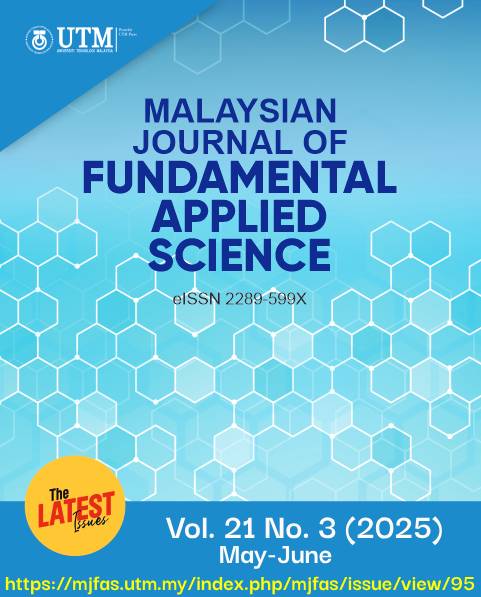Scale-Up Extraction of Zingiber officinale and Zingiber zerumbet Using a Turbo Extractor Distillator (TED) by Applying Constant Mass Transfer Coefficient
DOI:
https://doi.org/10.11113/mjfas.v21n3.3915Keywords:
Zingiber zerumbet, Zingiber officinale, scaling up, mass transfer coefficient, turbo extractor distillatory.Abstract
The scale-up studies of Zingiber officinale and Zingiber zerumbet extraction process were performed by investigating the constant mass transfer coefficient, kLa values in a 2L lab-scale. After determining the values of kLa on the 2L lab-scale by using Enhanced Diffusion Solid-Liquid Extraction (EDSLE) model , the limitations for the operating parameters in the 200L pilot-scale Turbo Extractor Distillator (TED) were computed. Impeller speeds, 200-600 rpm for 2L lab-scale and 50-500 rpm for 200L pilot-scale were manipulated to provide a condition similar to the 2L lab-scale. The optimal scale-up extraction conditions for Zingiber officinale were 90 minutes, 1:20 solid-to-solvent ratio, and 520 µm (powdered) particle size, while for Zingiber zerumbet, 90 minutes, 1:20 solid-to-solvent ratio, and 710 µm (powdered) particle size. By adjusting the operation speed, the 400-rpm speed gave the best fit with the highest R-squared above 0.9997 at the same time a constant kLa was kept as low as possible at both scales, 29.9769 m/min t 2L lab-scale and 28.5432 m/min at 200L pilot-scale. These results indicate that the model can be used to predict and describe the scale-up of the extraction process while maintaining process efficiency, providing a systematic approach to optimize large-scale herbal extraction with controlled operating parameters and reproducible results.
References
Zakaria, M. H., Rahimah, N. N., Nor, A. N., & Roslina, A. (2019). Transformation of herbal industry in Malaysia. Macro outlook of herbal industry in Malaysia, Agribusiness. Food and Fertilizer Technology for the Asian and Pacific Region (FFTC-AP), Malaysia.
Ahmad, S., & Othman, N. (2013). Strategic planning, issues, prospects, and the future of the Malaysian herbal industry. International Journal of Academic Research in Accounting, Finance and Management Sciences, 3(4), 91–102.
Maghraby, Y. R., et al. (2023). Gingerols and shogaols: A multi-faceted review of their extraction, formulation, and analysis in drugs and biofluids to maximize their nutraceutical and pharmaceutical applications. Food Chemistry: X, 100, 100947.
Koga, A. Y., Beltrame, F. L., & Pereira, A. V. (2016). Several aspects of Zingiber zerumbet: A review. Revista Brasileira de Farmacognosia, 26, 385–391.
Chien, T. Y., et al. (2008). Anti-inflammatory constituents of Zingiber zerumbet. Food Chemistry, 110(3), 584–589.
Zadorozhna, M., & Mangieri, D. (2021). Mechanisms of chemopreventive and therapeutic properties of ginger extracts in cancer. International Journal of Molecular Sciences, 22(12), 6599.
Mao, Q. Q., et al. (2019). Bioactive compounds and bioactivities of ginger (Zingiber officinale Roscoe). Foods, 8(6), 185.
Anh, N. H., et al. (2020). Ginger on human health: A comprehensive systematic review of 109 randomized controlled trials. Nutrients, 12(1), 157.
Chan, J. S. W., et al. (2024). Zingiber zerumbet: A scoping review of its medicinal properties. Planta Medica, 90(3), 204–218.
Yob, N. J., et al. (2011). Zingiber zerumbet (L.) Smith: A review of its ethnomedicinal, chemical, and pharmacological uses. *Evidence-Based Complementary and Alternative Medicine, 2011*, 543216.
Pradhan, S., & Sarkar, B. R. (2023). International Journal of Pharmacognosy, 10(6), 299–314.
Chan, J. S. W., et al. (2024). Zingiber zerumbet: A scoping review of its medicinal properties. Planta Medica, 90(3), 204–218.
Lau, C. H., & Chua, L. S. (2019). Pilot-scale extraction of Orthosiphon stamineus raw material as rosmarinic acid extract. AgriEngineering, 1(1), 94–99.
Soh, S. H., et al. (2019). Mathematical modeling of mass transfer in supercritical fluid extraction of patchouli oil. Engineering Reports, 1(4), e12051.
Aziz, R. A., et al. (2005). Engineering aspects of herbal and phytochemical processing: A Malaysian perspective. Jurutera, 010–019.
Yu, S., et al. (2023). Mass transfer and droplet behaviors in the liquid-liquid extraction process based on a multi-scale perspective: A review. Separations, 10(4), 264.
Fardhyanti, D. S., et al. (2017). Mass transfer coefficient in a stirred tank for p-cresol extraction process from coal tar. Journal of Physics: Conference Series, 824(1), 012019.
Alam, M. N., & Razali, F. I. (2005). Scale-up of stirred and aerated bioengineering bioreactor based on constant mass transfer coefficient. Jurnal Teknologi, 43(F), 95–110.
Eid, E. E. M., et al. (2010). Validated high-performance liquid chromatographic (HPLC) method for analysis of zerumbone in plasma. African Journal of Biotechnology, 9(8), 1260–1265.
Schwertner, H. A., & Rios, D. C. (2007). High-performance liquid chromatographic analysis of 6-gingerol, 8-gingerol, 10-gingerol, and 6-shogaol in ginger-containing dietary supplements, spices, teas, and beverages. Journal of Chromatography B, 856(1–2), 41–47.
Koya Kamal, Y. K. T., et al. (2015). Stability-indicating RP-HPLC method for the determination of 6-gingerol in polyherbal formulations. Journal of Analytical Science and Technology, 6, Article 23.
Zlokarnik, M. (2006). Scale-up in chemical engineering. John Wiley & Sons.
Pin, K. Y., et al. (2011). Solid‐liquid extraction of betel leaves (Piper betle L.). Journal of Food Process Engineering, 34(3), 549–565.
Belwal, T., et al. (2018). A critical analysis of extraction techniques used for botanicals: Trends, priorities, industrial uses, and optimization strategies. Trends in Analytical Chemistry, 100, 82–102.
Luque de Castro, M. D., & García-Ayuso, L. E. (1998). Soxhlet extraction of solid materials: An outdated technique with a promising innovative future. Analytica Chimica Acta, 369(1–2), 1–10.
Azwanida, N. N. (2015). A review on the extraction methods used in medicinal plants: Principles, strengths, and limitations. Medicinal & Aromatic Plants, 4(3), 1–6.
Downloads
Published
Issue
Section
License
Copyright (c) 2025 Rahimah Sabtu , Rosnani Hasham@Hisham, Siti Hasyimah Suhaimi, Mohd Azrie Awang , Noor Amirah Azelan

This work is licensed under a Creative Commons Attribution-NonCommercial 4.0 International License.




















